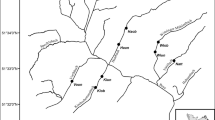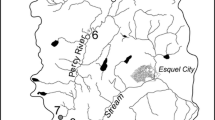Abstract
Compensating for the adverse ecological impacts of waterway development and improving their ecological functioning to achieve good ecological potential (GEP) have become mandatory within the European Union (EU). The technical rehabilitation measures presented here aim to functionally minimize the hydraulic impacts of navigation on aquatic biota in highly urbanized waterways. Their ecological functioning and potential to enhance biodiversity locally was assessed by comparing their macro-invertebrate community composition with nearby non-restored sites. Rehabilitation led to lower hydraulic impact on the littoral zone, which in turn led to the presence of otherwise missing macrophytes and the occurrence of organic mud habitats colonized by invertebrates typically rare in urban waterways. While the control sites were dominated by few, mostly invasive taxa in vast numbers, the rehabilitated sites exhibited a highly diverse community with 22 protected mollusc and insect taxa typically found in the oxbow communities of natural rivers. This major improvement was however not detected using the core metrics of the legally required national assessment tools of the EU Water Framework Directive. Overall results proved the success of this type of rehabilitation measure with respect to improving biodiversity, but they also showed the limiting and key factors influencing the macro-invertebrate communities of highly deteriorated urban waterways. Indeed, future implementations of this type of rehabilitation measure should consider spatial extent, water exchange rates, temporal succession of vegetation and adaptive management to improve its ecological functioning.





Similar content being viewed by others
References
bij de Vaate A, Jazdzewski K, Ketelaars HA, Gollasch S, van der Velde G (2002) Geographical patterns in range extension of Ponto-Caspian macroinvertebrate species in Europe. Can J Fish Aquat Sci 59:1159–1174. doi:10.1139/f02-098
Caraco N, Cole J, Findlay S, Wigand C (2006) Vascular plants as engineers of oxygen in aquatic systems. Bioscience 56:219–225. doi:10.1641/0006-3568(2006)056[0219:VPAEOO]2.0.CO;2
Cyr H, Downing JA (1988) The abundance of phytophilous invertebrates on different species of submerged macrophytes. Freshw Biol 20:365–374. doi:10.1111/j.1365-2427.1988.tb00462.x
Dall PC (1979) A sampling technique for littoral stone dwelling organisms. Oikos 33:106–112
Diehl S, Kornijów R (1998) Influence of submerged macrophytes on trophic interactions among fish and macroinvertebates. In: Jeppesen E, Søndergaard M, Søndergaard M, Christoffersen K (eds) The structuring role of submerged macrophytes in lakes. Springer, New York, pp 24–46
Doyle RD (2001) Effects of waves on the early growth of Vallisneria americana. Freshw Biol 46:389–397. doi:10.1046/j.1365-2427.2001.00668.x
Dudgeon D, Arthington AH, Gessner MO, Kawabata Z-I, Knowler DJ, Lévêque C, Naiman RJ, Prieur-Richard A-H, Soto D, Stiassny MLJ, Sullivan CA (2006) Freshwater biodiversity: importance, threats, status and conservation challenges. Biol Rev 81:163–182. doi:10.1017/S1464793105006950
Dufrene M, Legendre P (1997) Species assemblages and indicator species: the need for a flexible asymmetrical approach. Ecol Monogr 67:345–366. doi:10.1890/0012-9615(1997)067[0345:SAAIST]2.0.CO;2
Eriksson B, Sandstrom A, Isæus M, Schreiber H, Karås P (2004) Effects of boating activities on aquatic vegetation in the Stockholm archipelago, Baltic Sea. Estuar Coast Shelf S 61:339–349. doi:10.1016/j.ecss.2004.05.009
Francis RA (2014) Urban rivers: novel ecosystems, new challenges. Wiley Interdiscip Rev: Water 1:19–29. doi:10.1002/wat2.1007
Gabel F, Garcia X-F, Brauns M, Sukhodolov A, Leszinski M, Pusch MT (2008) Resistance to ship-induced waves of benthic invertebrates in various littoral habitats. Freshw Biol 53:1567–1578. doi:10.1111/j.1365-2427.2008.01991.x
Gabel F, Pusch MT, Breyer P, Burmester V, Walz N, Garcia X-F (2011a) Differential effect of wave stress on the physiology and behaviour of native versus non-native benthic invertebrates. Biol Invasions 13:1843–1853. doi:10.1007/s10530-011-0003-1
Gabel F, Stoll S, Fischer P, Pusch MT, Garcia X-F (2011b) Waves affect predator-prey interactions between fish and benthic invertebrates. Oecologia 165:101–109. doi:10.1007/s00442-010-1841-8
Gabel F, Garcia X-F, Schnauder I, Pusch MT (2012) Effects of ship-induced waves on littoral benthic invertebrates. Freshw Biol 57:2425–2435. doi:10.1111/fwb.12011
Gallardo B, García M, Cabezas Á, González E, González M, Ciancarelli C, Comín FA (2008) Macroinvertebrate patterns along environmental gradients and hydrological connectivity within a regulated river-floodplain. Aquat Sci 70:248–258. doi:10.1007/s00027-008-8024-2
Gallardo B, Dolédec S, Paillex A, Arscott DB, Sheldon F, Zilli F, Mérigoux S, Castella E, Comín FA (2014) Response of benthic macroinvertebrates to gradients in hydrological connectivity: a comparison of temperate, subtropical, Mediterranean and semiarid river floodplains. Freshw Biol 59:630–648. doi:10.1111/fwb.12292
Giraudoux P (2016) pgirmess: Data analysis in ecology (Version 1.6.4). https://cran.r-project.org/package=pgirmess. Accessed 30 March 2016
Graça MAS (2001) The role of invertebrates on leaf litter decomposition in streams - a review. Int Rev Hydrobiol 86:383–393. doi:10.1002/1522-2632(200107)86:4/5<383::AID-IROH383>3.0.CO;2-D
Hering D, Moog O, Sandin L, Verdonschot PFM (2004) Overview and application of the AQEM assessment system. Hydrobiologia 516:1–20. doi:10.1023/B:HYDR.0000025255.70009.a5
Hoggart SPG, Francis RA, Chadwick MA (2012) Macroinvertebrate richness on flood defence walls of the tidal river Thames. Urban Ecosyst 15:327–346. doi:10.1007/s11252-011-0221-4
Kaden S, Kantelberg G, Rehfeld-Klein M, Sauer C, Schumacher F, Walther J (2002) Hydrologie. In: Köhler J, Gelbrecht J, Pusch MT (eds) Die Spree - Zustand, Probleme, Entwicklungsmöglichkeiten, Limnologie Aktuell Vol. 10. Schweizerbart Science Publishers, Stuttgart, pp 37–61
Karatayev AY, Burlakova LE, Padilla DK, Mastitsky SE, Olenin S (2009) Invaders are not a random selection of species. Biol Invasions 11:2009–2019. doi:10.1007/s10530-009-9498-0
Kornijów R, Moss B (2003) Do night oxygen depletions contribute to the summer decline in abundance of zoobenthos in lake littoral? Int Ver the 28:1899–1901
Kornijow R, Strayer DL, Caraco NF (2010) Macroinvertebrate communities of hypoxic habitats created by an invasive plant (Trapa natans) in the freshwater tidal Hudson River. Fundam Appl Limnol 176:199–207. doi:10.1127/1863-9135/2010/0176-0199
Lamouroux N, Dolédec S, Gayraud S (2004) Biological traits of stream macroinvertebrate communities: effects of microhabitat, reach, and basin filters. J N Am Benthol Soc 23:449–466. doi:10.1899/0887-3593(2004)023<0449:BTOSMC>2.0.CO;2
LAWA (Bund/Länder-Arbeitsgemeinschaft Wasser) (2013) Handbuch zur Bewertung und planerischen Bearbeitung von erheblich veränderten Gewässern (HMWB) und künstlichen Gewässern (AWB) http://www.nlwkn.niedersachsen.de/download/81142/Handbuch_zur_Bewertung_HMWB_und_AWB.pdf. Accessed 30 March 2016
Lodge DM (1991) Herbivory on freshwater macrophytes. Aquat Bot 41:195–224. doi:10.1016/0304-3770(91)90044-6
Lorenz S, Gabel F, Dobra N, Pusch MT (2013) Modelling the effects of recreational boating on self-purification activity provided by bivalve mollusks in a lowland river. Freshwater Sci 32:82–93. doi:10.1899/12-054.1
McMahon RF (1983) Physiological ecology of freshwater pulmonates. In: Rusell-Hunter WD (ed) The Mollusca, Ecology, vol 6. Academic Press, New York, pp 359–430
Meier C, Haase P, Rolauffs P, Schindehütte K, Schöll F, Sundermann A, Hering D (2006) Methodisches Handbuch Fließgewässerbewertung. Handbuch zur Untersuchung und Bewertung von Fließgewässern auf der Basis des Makrozoobenthos vor dem Hintergrund der EG-Wasserrahmenrichtlinie. http://www.fliessgewaesserbewertung.de/downloads/abschlussbericht_20060331_anhang_IX.pdf. Accessed 30 March 2016
Miranda LE (2005) Fish assemblages in Oxbow Lakes relative to connectivity with the Mississippi River. T Am Fish Soc 134:1480–1489. doi:10.1577/T05-057.1
Murphy KJ, Eaton JW (1983) Effects of pleasure-boat traffic on macrophyte growth in canals. J Appl Ecol 20:713–729. doi:10.2307/2403122
Oksanen J, Blanchet FG, Kindt R, Legendre P, Minchin PR, O’Hara RB, Simpson GL, Solymos P, Stevens MHH, Wagner H (2016) vegan: Community Ecology Package (Version 2.3–4). https://cran.r-project.org/package=vegan. Accessed 30 March 2016
Paul MJ, Meyer JL (2001) Streams in the urban landscape. Annu Rev Ecol Syst 32:333–365. doi:10.1007/978-0-387-73412-5_12
Pusch MT, Michels U, Feld CK, Berger T, Garcia X-F, Grünert U, Klausnitzer B (2002) Benthische Wirbellose. In: Köhler J, Gelbrecht J, Pusch MT (eds) Die Spree - Zustand, Probleme, Entwicklungsmöglichkeiten, Limnologie Aktuell Vol. 10. Schweizerbart Science Publishers, Stuttgart, pp 166–185
R Development Core Team (2016) R: A language and environment for statistical computing (Version 3.2.4). https://www.r-project.org. Accessed 30 March 2016
Rahel FJ (2002) Homogenization of freshwater faunas. Annu Rev Ecol Syst 33:291–315. doi:10.1146/annurev.ecolsys.33.010802.150429
Roberts DW (2016) labdsv: Ordination and Multivariate Analysis for Ecology (Version 1.8–0). https://cran.r-project.org/package=labdsv. Accessed 30 March 2016
Schmidt-Kloiber A, Hering, D (2013) www.freshwaterecology.info - the taxa and autecology database for freshwater organisms. http://www.freshwaterecology.info. Accessed 28 October 2013
Schröder M, Kiesel J, Schattmann A, Jähnig SC, Lorenz AW, Kramm S, Keizer-Vlek H, Rolauffs P, Graf W, Leitner P, Hering D (2013) Substratum associations of benthic invertebrates in lowland and mountain streams. Ecol Indic 30:178–189. doi:10.1016/j.ecolind.2013.02.012
SenGUV (Senatsverwaltung für Gesundheit, Umwelt und Verbraucherschutz) (2007) Bewertung des ökologischen Zustandes der Berliner Spree anhand des Makrozoobenthos ausgewählter Flussabschnitte. Germany, Berlin http://www.stadtentwicklung.berlin.de/umwelt/wasser/download/Stadtspree-Potenziale_Oktober2007.pdf. Accessed 30 March 2016
SenGUV (Senatsverwaltung für Gesundheit, Umwelt und Verbraucherschutz) (2010) Untersuchung des Makrozoobenthos in ausgewählten großen Fließgewässern und Kanälen von Berlin. Germany, Berlin http://www.stadtentwicklung.berlin.de/umwelt/wasser/download/Makrozoobenthos_Fliessgew.pdf. Accessed 30 March 2016
SenStadtUm (Senatsverwaltung für Stadtentwicklung und Umwelt) (2005) Datenbank für das Gesamtregister der Pflanzen- und Tierarten in den Berliner Roten Listen 2005 (Version 2.8). Berlin, Germany. http://www.stadtentwicklung.berlin.de/natur_gruen/naturschutz/artenschutz/download/rote_listen/datenbank.zip. Accessed 30 March 2016
Söhngen B, Koop J, Knight S, Rythönen J, Beckwith P, Ferrari N, Iribarren J, Keevin T, Wolter C, Maynord S (2008) Considerations to reduce environmental impacts of vessels, report n°9. PIANC, Brussels
Strayer DL (2012) Eight questions about invasions and ecosystem functioning. Ecol Lett 15:1199–1210. doi:10.1111/j.1461-0248.2012.01817.x
Strayer DL, Findlay SEG (2010) Ecology of freshwater shore zones. Aquat Sci 72:127–163. doi:10.1007/s00027-010-0128-9
Strayer DL, Lutz C, Malcom HM, Munger K, Shaw WH (2003) Invertebrate communities associated with a native (Vallisneria americana) and an alien (Trapa natans) macrophyte in a large river. Freshw Biol 48:1938–1949. doi:10.1046/j.1365-2427.2003.01142.x
Sukhodolova T, Weber A, Zhang J, Wolter C (2017) Effects of macrophyte development on the oxygen metabolism of an urban river rehabilitation structure. Sci Total Environ 574:1125–1130. doi:10.1016/j.scitotenv.2016.08.174
van den Brink FWB, van der Velde G, bij de Vaate A (1993) Ecological aspects, explosive range extension and impact of a mass invader, Corophium curvispinum Sars, 1895 (Crustacea: Amphipoda), in the lower Rhine (the Netherlands). Oecologia 93:224–232. doi:10.1007/BF00317675
Vermaat JE, de Bruyne RJ (1993) Factors limiting the distribution of submerged waterplants in the lowland river Vecht (the Netherlands). Freshw Biol 30:147–157. doi:10.1111/j.1365-2427.1993.tb00795.x
Vermonden K, Leuven RSEW, van der Velde G (2010) Environmental factors determining invasibility of urban waters for exotic macroinvertebrates. Divers Distrib 16:1009–1021. doi:10.1111/j.1472-4642.2010.00702.x
Walker PD, Wijnhoven S, van der Velde G (2013) Macrophyte presence and growth form influence macroinvertebrate community structure. Aquat Bot 104:80–87. doi:10.1016/j.aquabot.2012.09.003
Warfe DM, Barmuta LA (2004) Habitat structural complexity mediates the foraging success of multiple predator species. Oecologia 141:171–178. doi:10.1007/s00442-004-1644-x
Weber A, Lautenbach S, Wolter C (2012) Improvement of aquatic vegetation in urban waterways using protected artificial shallows. Ecol Eng 42:160–167. doi:10.1016/j.ecoleng.2012.01.007
Weber A, Zhang J, Nardin A, Sukhodolov A, Wolter C (2016) The influence of aquatic vegetation on the hydrodynamics of an alternative bank protection measure in a navigable waterway. River Res Appl 32:2071–2080. doi:10.1002/rra.3052
Williams DD, Feltmate BW (1992) Aquatic insects. CAB International, Wallingford, Oxon
Wolter C (2010) Functional vs scenic restoration - challenges to improve fish and fisheries in urban waters. Fish Manag Ecol 17:176–185. doi:10.1111/j.1365-2400.2009.00725.x
Wolter C, Arlinghaus R, Sukhodolov A, Engelhardt C (2004) A model of navigation-induced currents in inland waterways and implications for juvenile fish displacement. Environ Manag 34:656–668. doi:10.1007/s00267-004-0201-z
Acknowledgements
We thank C. Schomaker, O. Schröder, S. Hane and G. Simon for their assistance during the field work. L. Engel, M. Mährlein, M. Beck, J. Schreiber and M. Brauns helped with the sample processing and determination of the invertebrates. T. Hintze provided his technical assistance for the pressure loggers. Mrs. Heide Bogumil from Wasserstraßen-Neubauamt Berlin kindly provided the vessel counts for the locks at Charlottenburg and Kleinmachnow in 2009. A. McFall commented on the English language.
This study has been funded as part of the IWRM-net project “FORECASTER” by the German Federal Ministry for Education and Research (grant number 02WM1031). X-FG and CW received further funding by the European Union FP7 project “REFORM” (grant number 282656).
Author information
Authors and Affiliations
Corresponding author
Rights and permissions
About this article
Cite this article
Weber, A., Garcia, XF. & Wolter, C. Habitat rehabilitation in urban waterways: the ecological potential of bank protection structures for benthic invertebrates. Urban Ecosyst 20, 759–773 (2017). https://doi.org/10.1007/s11252-017-0647-4
Published:
Issue Date:
DOI: https://doi.org/10.1007/s11252-017-0647-4




